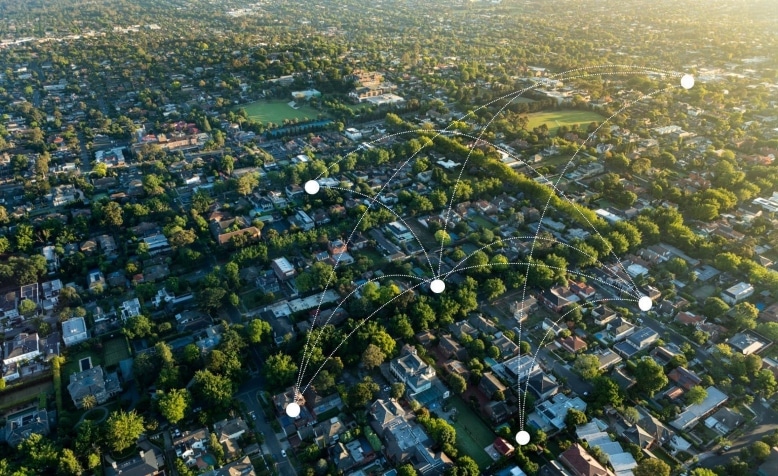Broadband Office Name: Indiana Broadband Office (IBO)
BEAD Award Amount: $868.1 M
Indiana Broadband Director: Amanda O’Daniel
Website: https://www.in.gov/indianabroadband/
Indiana BEAD Program Tracker
| State | IP Vol 1 Approval | IP Vol 2 Approval | Challenge Process Submission Closed | Challenge Process Final Determination Phase Completed | 1-Year Subgrantee Selection Process |
|---|---|---|---|---|---|
| Indiana | Yes | Yes | Yes | Yes | Yes |
Indiana BEAD Program Information

Key Updates
The Indiana Broadband Office (IBO) completed the Final Determination stage of the Challenge Process.
The Final Determination stage closed on July 1, 2024. Following this, the IBO submitted the results from this Challenge Process to NTIA for approval.
The Indiana Broadband Office (IBO) received the NTIA’s approval on their BEAD Initial Proposal Volume 2. Click here for more information.
Indiana BEAD Program Plans & Maps
Indiana BEAD Program Initial Proposal Volume 2: Overview
BEAD Long-Term Objectives
Indiana Broadband Office (IBO) Goals and Objectives:
- Future-Proof Broadband Deployment:
- Objective: Ensure all broadband serviceable locations (BSLs), including households, businesses, farms, and Community Anchor Institutions (CAIs), are served.
- Strategies:
- BSL identification.
- BSL grouping.
- Alternative methods of delivery.
- Effective Internet Use and Digital Services:
- Objective: Help all Hoosiers use the internet effectively and increase adoption of digital services.
- Strategies:
- Affordability.
- Adoption.
- Digital equity.
- Commitment to Digital Equity:
- Objective: Address digital equity and adapt to new challenges to provide additional support to communities.
- Strategies:
- Community coordination.
- Community input.
- Community collaboration.
- Promote Quality Jobs and Community Development:
- Objective: Enhance quality jobs, community development, and quality of life.
- Strategies:
- Community impact.
- Workforce development and job growth.
- Business growth.
Indiana BEAD Program Project Area Design
The project areas for broadband deployment in Indiana are tied to two different application rounds:
- First Round:
- Applicants can define their own areas at the Census Block Group (CBG) level, at minimum.
- These areas must be contiguous.
- Following Rounds:
- The Indiana Broadband Office (IBO) will determine the areas using locations left over from the first round.
- In the second and third rounds, a project area could be as small as a single Broadband Serviceable Location (BSL).
Indiana BEAD Program Extremely High Cost Threshold
IBO will use a modified Fiber Broadband Association (FBA) BEAD Threshold Financial Model to determine the Extremely High Cost Threshold.
BEAD Deployment Subgrantee Selection
IBO is asking for the following preregistration evidence from subgrantees and compliance with: Financial capability, managerial capability, operational capability, technical capability, ownership info, public funding info, compliance with laws, cybersecurity/supply chain compliance, and BABA/EHP/NEPA/NHPA compliance.
Primary Scoring Criteria for Priority Broadband Projects
- 50 pts – Minimal BEAD Outlay
- 20 pts – Affordability
- 5 pts – Labor Standards
Secondary Scoring Criteria
- 5 pts – Speed to Deployment
- 10 pts – Percent Unserved Areas
- 5 pts – Local Coordination
- 5 pts – Project Match Percentage
Primary Scoring Criteria for Last-Mile Broadband Projects
- 50 pts – Minimal BEAD Outlay
- 20 pts – Affordability
- 5 pts – Labor Standards
Secondary Scoring Criteria
- 2.5 pts – Speed to Deployment
- 2.5 pts – Speed of Network and Other Technical Capabilities
- 10 pts – Percent Unserved Areas
- 5 pts – Local Coordination
- 5 pts – Project Match Percentage
BEAD Non-Deployment Subgrantee Selection
IBO does not intend to subgrant for any non-deployment activities.
BEAD Eligible Entity Implementation
IBO plans to conduct BEAD implementation and deployment activities as the recipient of BEAD funds without making a subgrant:
- Public Comment and Local Coordination:
- Facilitate public comment and local coordination throughout the planning and deployment phases.
- Use a small portion of funds for travel, materials for public comment and engagement, and additional IBO employees.
- Statewide Challenge Process:
- Plan and run the statewide challenge process with support from Ready.Net.
- Subgrantee Selection and Grant Management:
- Manage the subgrantee selection process and all subsequent grant management activities, including:
- Prequalification of potential subgrantees.
- Development and implementation of the subgrantee selection process.
- Scoring and selection of subgrantees.
- Ensuring grant compliance.
- Coordinating between subgrantees, local, and regional groups during deployment projects.
- Manage the subgrantee selection process and all subsequent grant management activities, including:
BEAD Local, Tribe, and Regional Broadband Planning Process
Indiana Broadband Office (IBO) Stakeholder Engagement Methods:
- Community Feedback:
- Initiated with 18 listening sessions during the Five-Year Action Plan.
- Ongoing feedback sessions to continually gather community input.
- ISP Engagement:
- Frequent communication with ISPs to understand and address new areas of concern.
- Flexible partnership approach to accommodate ISP needs.
- IBO as a Connector:
- Facilitates positive relationships between communities and ISPs.
- Acts as a bridge to foster collaboration and understanding.
- Partnership Establishment:
- Collaborates with community partners to advertise the Indiana speed test and collect precise mapping data.
- Speed test available at connectingindiana.com.
- Third-Party Engagement:
- Maintains open conversations with third-party entities to prevent delays in the construction process.
- Workforce Development:
- Collaborates with the Department of Workforce Development (DWD), other state/local government entities, ISPs, and educational institutions.
- Identifies workforce development partners to support broadband deployment and maintenance.
BEAD Labor Standards & Protection
IBO requires all BEAD subgrantees to submit the following information:
A record of past compliance with federal/employment laws:
- Must address info on deployment projects within the last 3 years.
- Certification form from an Officer/Director level employee of past compliance.
- Written confirmation that subgrantee has disclosed any violations from contractors within the last 3 years.
- Discussion of workforce plan
Plans for ensuring compliance with federal/employment laws:
- How subgrantee will ensure compliance in its labor/employment practices.
- Info on applicable wage scales, wage, and overtime practices for each class of employee expected to be involved in physical construction of the network.
- How subgrantee will ensure implementation of workplace safety committees.
- Comply with the Prevailing Wages Act.
- Other items as outlined in the BEAD NOFO.
BEAD Minority Business Enterprises / Women’s Business Enterprises / Labor Surplus Area Firms Inclusion
IBO is aligned with the key objectives of the Indiana Department of Administration (IDOA) Division of Supplier Diversity, which include adding value to Indiana’s economy, establishing strategic partnerships, and positioning minority, women, and veteran-owned businesses for growth.
Affirmative Steps by IBO:
- Solicitation Lists: Placing qualified small and minority businesses and women’s business enterprises on solicitation lists.
- Ensuring Solicitation: Assuring that small and minority businesses, and women’s business enterprises are solicited whenever they are potential sources.
- Task Division: Dividing total requirements, when economically feasible, into smaller tasks or quantities to permit maximum participation by small and minority businesses and women’s business enterprises.
- Encouraging Participation: Establishing delivery schedules, where the requirement permits, which encourage participation by small and minority businesses and women’s business enterprises.
- Using Assistance Services: Utilizing the services and assistance of organizations such as the Small Business Administration and the Minority Business Development Agency of the Department of Commerce.
- Subgrantee Requirements: Requiring subgrantees to take the affirmative steps listed above as they relate to subcontractors.
BEAD Cost & Barrier Reduction
1. Promoting the use of existing infrastructure.
2. Promoting and adapting dig-once policies.
3. Streamlining permitting processes.
4. Streamlining cost-effective access to poles, conduits, and easements.
5. Streamlining rights of way, including the imposition of reasonable access requirements.
BEAD Low-Cost Broadband Service Option
IBO’s Minimum Requirements for Low-Cost Service Options:
- Affordable Pricing: Costs less than the threshold set by an annually reviewed methodology, inclusive of all taxes, fees, and charges.
- ACP Compatibility: Allows end users to apply for the Affordable Connectivity Program (ACP).
- Service Specifications: Provides speeds of 100/20 Mbps and latency measurements of 100 milliseconds.
- No Restrictions: Not subject to data caps, surcharges, or usage-based throttling.
- Upgrade Flexibility: If the provider later offers a low-cost plan with higher speeds downstream and/or upstream, it permits Eligible Subscribers subscribed to a low-cost broadband service option to upgrade to the new low-cost offering at no cost.
- ACP Participation: All subgrantees are required to participate in the ACP.
Low-Cost Plan Calculation:
An applicant’s monthly plan will be considered low-cost if it is equal to or less than 2% of the maximum eligible annual income for ACP for a household of one, divided by twelve.
Example Calculation:
- ACP’s maximum eligible annual income for a household of one is $29,160.
- Divided by twelve, this is $2,430 per month.
- For 2023, the maximum monthly charge for a low-cost plan would be 2% of $2,430, which equals $48.60.
BEAD Middle-Class Affordability
The Indiana Broadband Office (IBO) will encourage all providers participating in the BEAD program to offer an affordable option for 100/20 Mbps service. The IBO recommends that this plan’s price be no higher than the rates for 100/20 service provided in the FCC’s United States Broadband Benchmark Rate Calculator.
For 2023, the US benchmark rate for 100/20 service is $104.99. As the Urban Rate Survey data is released each year, the IBO will notify all subgrantees about the updated benchmark for 100/20 service and promote middle-class affordability plans in alignment with the new benchmark.

